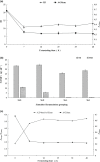Evolution of nonenzymatic browning during the simulated Msalais-production process in models of grape juice
- PMID: 35844914
- PMCID: PMC9281960
- DOI: 10.1002/fsn3.2829
Evolution of nonenzymatic browning during the simulated Msalais-production process in models of grape juice
Abstract
Msalais is a wine fermented from boiled grape juice. Nonenzymatic browning (NEB) greatly affects the quality of Msalais, but to date its mechanism has not been systematically analyzed. In the current study, the evolution of NEB during Msalais production was investigated using models of grape juice. 5-Hydroxymethylfurfural (5-HMF), browning index (BI), yellowness index (YI), sample absorbance at 420 (A420), and b* increased during heating, with a clear transition point at 110 min. The Maillard reaction (MR) was the major contributor to NEB. Vitamin C (VC) facilitated NEB in the late stage of heating. During heating that lasted over 130 min, glucose contributed to NEB more than fructose, while the reverse was true for heating lasting less than 130 min. Proline (Pro) was the most important amino acid in facilitating NEB. BI and A420 decreased during fermentation, while increasing slightly during wine storage. In conclusion, this study identified the evolution of NEB during the Msalais process, which will facilitate the control of traditional Msalais production for improved wine quality.
Keywords: boiled grape juice; maillard reaction; model; msalais; nonenzymatic browning; wine.
© 2022 The Authors. Food Science & Nutrition published by Wiley Periodicals LLC.
Conflict of interest statement
The funders had no role in the design of the study; in the collection, analyses, or interpretation of data; in the writing of the manuscript or in the decision to publish the results.
Figures



References
-
- Ajandouz, E. H. , & Puigserver, A. (1999). Nonenzymatic browning reaction of essential amino acids: Effect of pH on caramelization and maillard reaction kinetics. Journal of Agricultural and Food Chemistry, 47, 1786–1793. - PubMed
-
- Ajandouz, E. H. , Tchiakpe, L. S. , Ore, F. D. , Benajiba, A. , & Puigserver, A. (2001). Effects of pH on caramelization and Maillard reaction kinetics in fructose‐lysine model systems. Journal of Food Science, 66, 926–931.
-
- Arihara, K. , Yokoyama, I. , & Ohata, M. D. M. H. F. (2019). (2,5‐dimethyl‐4‐hydroxy‐3(2H)‐furanone), a volatile food component with attractive sensory properties, brings physiological functions through inhalation (1st ed.). Elsevier Inc. - PubMed
-
- Bakeshlou, H. , Pirouzifard, M. K. , Alizadeh, M. , & Amiri, S. (2020). Investigation of non‐enzymatic browning characteristics of Sardasht black grape juice concentrate using Response Surface Methodology. Food Science and Technology, 6, 127–136.
-
- Barbanti, D. , Mastrocola, D. , & Lerici, C. R. (1990). Early indicators of chemical changes in foods due to enzymic or non enzymic browning reactions. II. Colour changes in heat treated model systems. Lab Technology, 23, 494–498.
LinkOut - more resources
Full Text Sources

